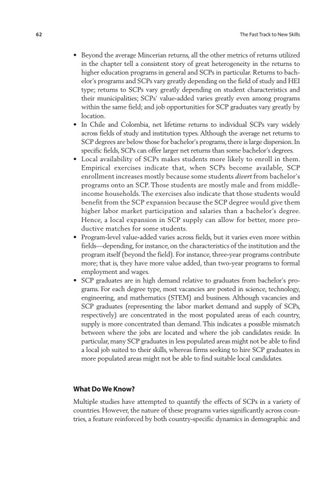62
The Fast Track to New Skills
• Beyond the average Mincerian returns, all the other metrics of returns utilized in the chapter tell a consistent story of great heterogeneity in the returns to higher education programs in general and SCPs in particular. Returns to bachelor’s programs and SCPs vary greatly depending on the field of study and HEI type; returns to SCPs vary greatly depending on student characteristics and their municipalities; SCPs’ value-added varies greatly even among programs within the same field; and job opportunities for SCP graduates vary greatly by location. • In Chile and Colombia, net lifetime returns to individual SCPs vary widely across fields of study and institution types. Although the average net returns to SCP degrees are below those for bachelor’s programs, there is large dispersion. In specific fields, SCPs can offer larger net returns than some bachelor’s degrees. • Local availability of SCPs makes students more likely to enroll in them. Empirical exercises indicate that, when SCPs become available, SCP enrollment increases mostly because some students divert from bachelor’s programs onto an SCP. Those students are mostly male and from middleincome households. The exercises also indicate that those students would benefit from the SCP expansion because the SCP degree would give them higher labor market participation and salaries than a bachelor’s degree. Hence, a local expansion in SCP supply can allow for better, more productive matches for some students. • Program-level value-added varies across fields, but it varies even more within fields—depending, for instance, on the characteristics of the institution and the program itself (beyond the field). For instance, three-year programs contribute more; that is, they have more value added, than two-year programs to formal employment and wages. • SCP graduates are in high demand relative to graduates from bachelor’s programs. For each degree type, most vacancies are posted in science, technology, engineering, and mathematics (STEM) and business. Although vacancies and SCP graduates (representing the labor market demand and supply of SCPs, respectively) are concentrated in the most populated areas of each country, supply is more concentrated than demand. This indicates a possible mismatch between where the jobs are located and where the job candidates reside. In particular, many SCP graduates in less populated areas might not be able to find a local job suited to their skills, whereas firms seeking to hire SCP graduates in more populated areas might not be able to find suitable local candidates.
What Do We Know? Multiple studies have attempted to quantify the effects of SCPs in a variety of countries. However, the nature of these programs varies significantly across countries, a feature reinforced by both country-specific dynamics in demographic and

